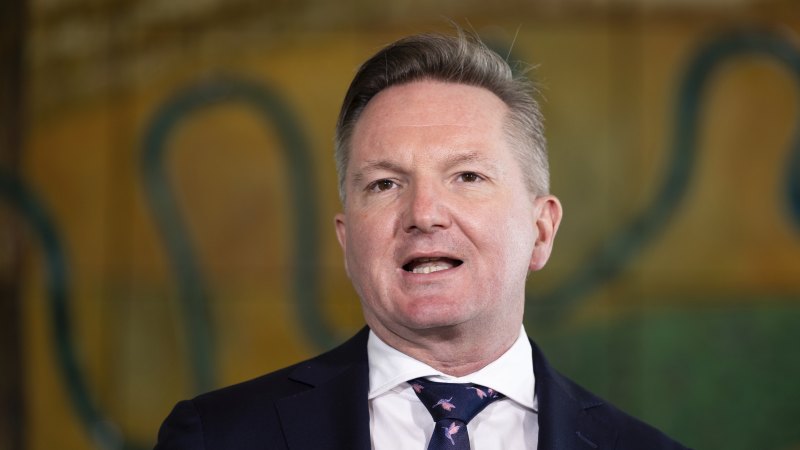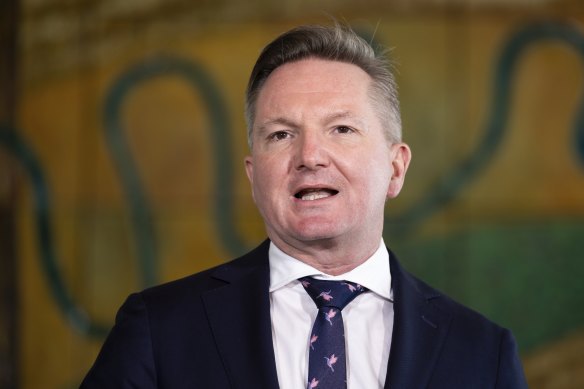Save articles for later
Add articles to your saved list and come back to them any time.
Climate Change Minister Chris Bowen says Australia is already closing in on its 2030 emissions reduction target, despite environment groups’ claims that support for fossil fuels is undercutting the nation’s green ambitions.
The annual Climate Change Statement, which Bowen will formally respond to in parliament on Thursday, shows Australia is on track to cut greenhouse emissions by 42 per cent below 2005 levels by 2030 – just shy of Labor’s 43 per cent target. This is an improvement on last year’s projections which had Australia tracking for a 40 per cent reduction.
Climate Change and Energy Minister Chris Bowen will table the annual climate change statement in the parliament next week showing Australia is on track to meet its 2030 emissions reduction target.Credit: Alex Ellinghausen
Climate experts and environmental groups have repeatedly criticised the target for falling short of international obligations.
Under the Paris Agreement, nations have pledged to keep global warming to as close to 1.5 degrees as possible. The government’s goal to cut emissions 43 per cent by 2030 is consistent with global action that misses the Paris target and delivers global warming of 2 degrees or more.
But Bowen defended the government’s progress, saying the latest emissions projections showed that “our 43 per cent target is ambitious but achievable”.
“Our actions to work with Australian industry and community, to reform the Safeguard Mechanism,
spur new firmed renewables through our Capacity Investment Scheme and improve EV uptake are
making a significant difference to Australia’s emissions, but we need a whole-of-society effort,” he said in a statement.
“As our trading partners ramp up their own transitions, reducing emissions isn’t just a climate
imperative but critical for keeping competitive – especially creating jobs in the regions, exporting
clean energy, products and resources to the world.”
The projections come as the minister prepares to depart for the United Nations COP28 climate change conference in Dubai next week. He will head to the summit with a sweeping renewable energy policy announced last week, called the Capacity Investment Scheme.
The government’s major source of emissions reduction will come from shrinking the amount of coal-fired power in the electricity grid and replacing it with renewables. The scheme will funnel billions of taxpayer dollars to underwriting renewable energy projects to raise the share of clean electricity generation from about 35 per cent of the grid to 82 per cent by the end of the decade.
The new projections show since it formed government, Labor has raised the forecast volume of emissions reduction by more than 400 million tonnes until the end of the decade.
Projections under the former Coalition government, from October 2021, showed Australia was on track to cut its emissions by only 30 per cent by 2030.
Addressing the NSW Liberal state convention on Saturday, Opposition Leader Peter Dutton attacked Bowen’s Capacity Investment Scheme as a “giant ponzi scheme”, and his renewables policy as “completely and utterly unsustainable”, while championing his own push for nuclear power to be part of the country’s energy mix.
“They’re going to underwrite contracts for energy companies regardless of whether prices fall or rise in the contracts that will be long run and put the Australian taxpayer on the hook for years and years, indeed decades to come, at a time when Australian families can’t afford it,” Dutton said.
Major environmental group the Australian Conservation Foundation claims that the government’s efforts are being undercut by its ongoing support for new coal and gas projects.
Analysis commissioned by the Conservation Foundation and prepared by Piers Verstegen from Climate Safe Solutions assessed 10 fossil-fuel projects, some of which are extensions of existing projects, that had received some level of approval under the Albanese government.
The analysis shows that if the projects proceed as planned, they would release more than 2.6 billion tonnes of carbon pollution over their lifetimes. These projects include Woodside’s gas fields on Western Australia’s North West Shelf, Idemitsu’s coal mine expansion at Boggabri in New South Wales, and BHP’s coal expansion at Caval Ridge in Queensland’s Bowen Basin.
“The Albanese government has made a range of positive climate commitments since being elected in 2022, but the pollution avoided by these initiatives is dwarfed by the emissions facilitated by the government’s continued approval of coal and gas projects,” Australian Conservation Foundation chief executive Kelly O’Shanassy said.
“This analysis shows the continued approval of and support for coal and gas projects is outweighing the impact of emissions-cutting programs by about seven-to-one.”
Separately, the Greens are pushing for the government to cancel $873 million in funding earmarked for eight Scott Morrison-era coal, oil and gas projects, which the independent Parliamentary Budget Office identified as having been committed but not contractually allocated.
“These Morrison-era projects haven’t gotten started and could be cancelled immediately. Labor
could find almost a billion dollars overnight if they did the right thing and withdrew public
funding for killing the planet,” Greens leader Adam Bandt said.
However, the government disputed the status of a number of the projects analysed by the PBO and said some funding had already been redirected.
A spokesman for Resources Minister Madeleine King said this included redirecting $30 million from the Cooper and Adavale Basins Strategic Plans to “critical energy security measures”, including reforms to the Australian Domestic Gas Security Mechanism. A further $14.3 million from Gas Well Trials initiative in the North Bowen and Galilee Basins Strategic Plans was redirected to a partnership with the Queensland Government to support research and development aimed at reducing emissions.
Start the day with a summary of the day’s most important and interesting stories, analysis and insights. Sign up for our Morning Edition newsletter.
Most Viewed in Politics
From our partners
Source: Read Full Article

